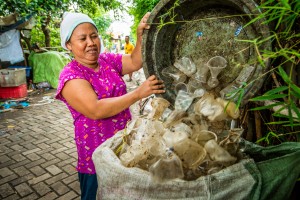Oikocredit Canada announced the wind down of its operations in Canada (November 29 | 2023). This marks the end of over 40 years of successful operations in Canada, effective Dec 31,2023. Click to read more.
Read more
Plastic Waste: A call to action
Plastic Waste: A call to action
With an island of plastic twice the size of Texas sitting in the North Pacific Ocean, plastic waste management is undeniably a problem both scientists and citizens alike need to be paying attention to. Although ocean pollution seems to dominate the news coverage, plastic pollution in freshwater is just as damaging. To put it in local context, there was found to be over a trillion plastic microfibers in Lake Ontario and, in certain fish that were tested, over 100 plastic microfibers were found in their digestive systems. Alarmingly, recent studies conclude that there are even microplastics found in our drinking water.
Plastics have been used in North America for a myriad of purposes since the 1950s. However, certain factors such as the rise of fast fashion and our increasingly convenience-obsessed, single use economy have driven plastic production and consumption to unsustainable alarming levels. Many products are advertised with slogans professing how easy the product is to use and then throw away. Currently only about 10% of plastic waste is recycled, the rest goes into our ever- growing landfills or worse, our precious waterways.
The magnitude of the global plastic problem is daunting, however there are steps that every individual can take to mitigate their harm to the environment and curb the unhealthy plastic consumption trends. The first method is to remember that the best way to decrease the amount of plastic in our landfills and waterways is to reduce our personal consumption. It is as simple as reminding ourselves to bring reusable bags to the grocery store or carrying a reusable water bottle. Another great option are filters that you can attach to your laundry machine water outlet hose, that can reduce the plastic microfibers extracted from clothing that goes into our lakes by 87%. If you are based in Toronto, I strongly recommend downloading the TOwaste App which can answer all of your queries as to what you can and cannot recycle.
The international community has acknowledged this problem and is taking action, evidenced by many countries, including Canada, banning microbeads, a type of plastic microfiber, as the beads were too small to be caught in any water treatment system and were extremely harmful to water ecosystems. The United Nations sustainable development goal #14 has pushed world leaders to start strategizing and planning for how to minimize consumption and more safely dispose of plastic. In 2018, the G7 even signed a Plastic Ocean Charter that discussed how each country could do its part in solving the plastic pollution problem. Oikocredit, through its investments in social enterprises, is also stepping up in a big way to combat plastic pollution. Through a partnership with Indonesian bank, Mitra Bisnis Keluarga, Oikocredit has given loans to Mias [pictured below] and her husband’s recycling business. The business currently employs six people and operates out of two locations. The loans increased the business’ profitability and, in the future, they hope to use the loans to expand by purchasing a small truck to help transport waste.

Although the situation may seem dire and the images alarming, with education, awareness and ultimately action, we can strive to reverse the damage done and aim for a brighter and cleaner future.

